A Comprehensive Report on Primark's Global Business Environment
VerifiedAdded on 2022/08/26
|19
|4813
|29
Report
AI Summary
This report provides a comprehensive analysis of Primark's global business environment. It begins with an introduction to the company, including its history, geographic spread, and market position. The report then delves into Primark's global value chain, examining inbound logistics, operations, outbound logistics, marketing and sales, and services, as well as secondary activities such as firm infrastructure, human resource management, technology development, and procurement. The analysis extends to Primark's entry modes, specifically franchising, and explores relevant internationalization theory. The report culminates in a review of Primark's current international strategy, offering recommendations and conclusions based on the preceding analysis. The report also includes Primark's financial performance and ethical trading initiatives. The report aims to provide a concise and current rather than historical overview of the organization, focusing on its business interests, industry competition, workforce, and geographic spread.
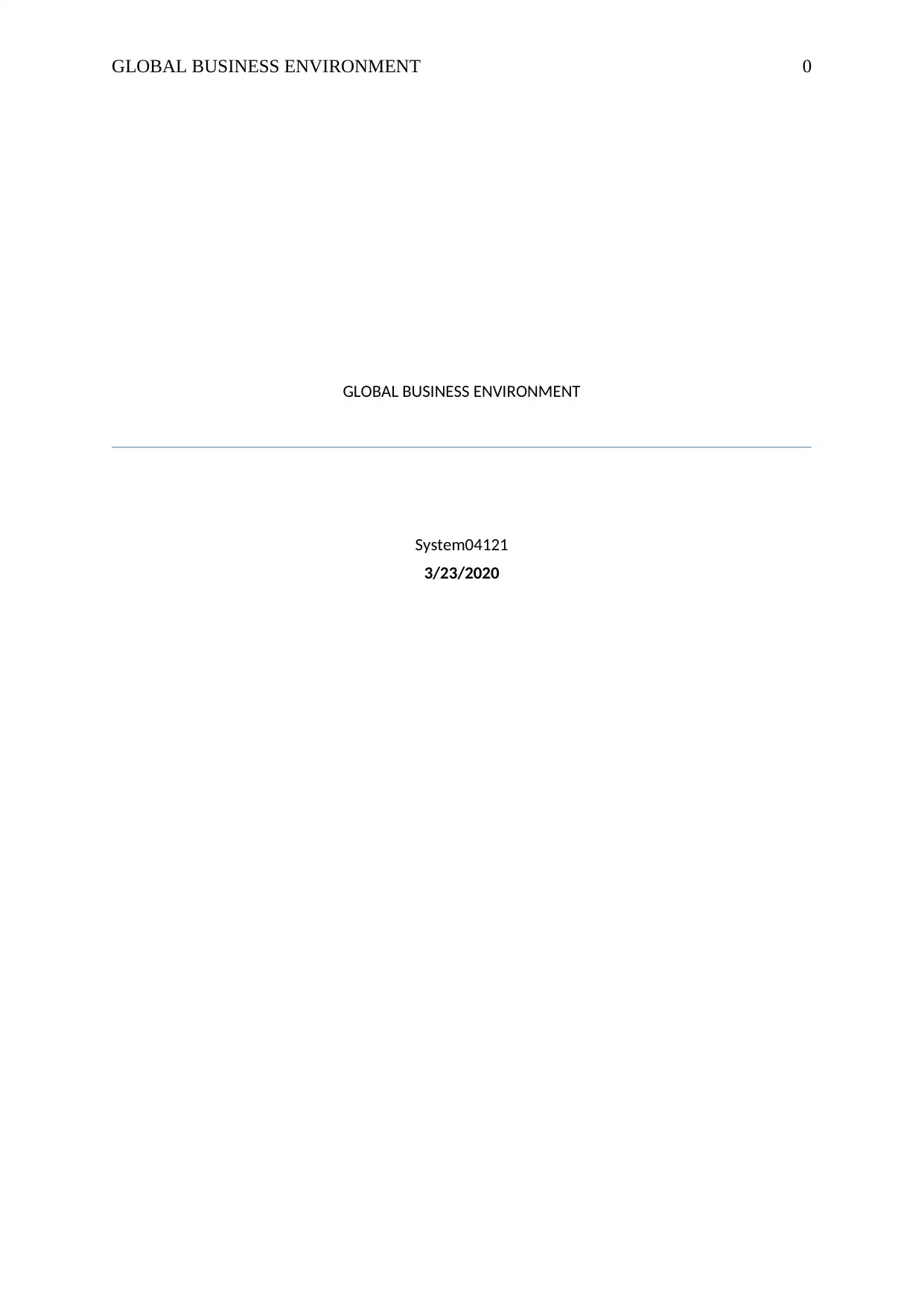
GLOBAL BUSINESS ENVIRONMENT 0
GLOBAL BUSINESS ENVIRONMENT
System04121
3/23/2020
GLOBAL BUSINESS ENVIRONMENT
System04121
3/23/2020
Paraphrase This Document
Need a fresh take? Get an instant paraphrase of this document with our AI Paraphraser
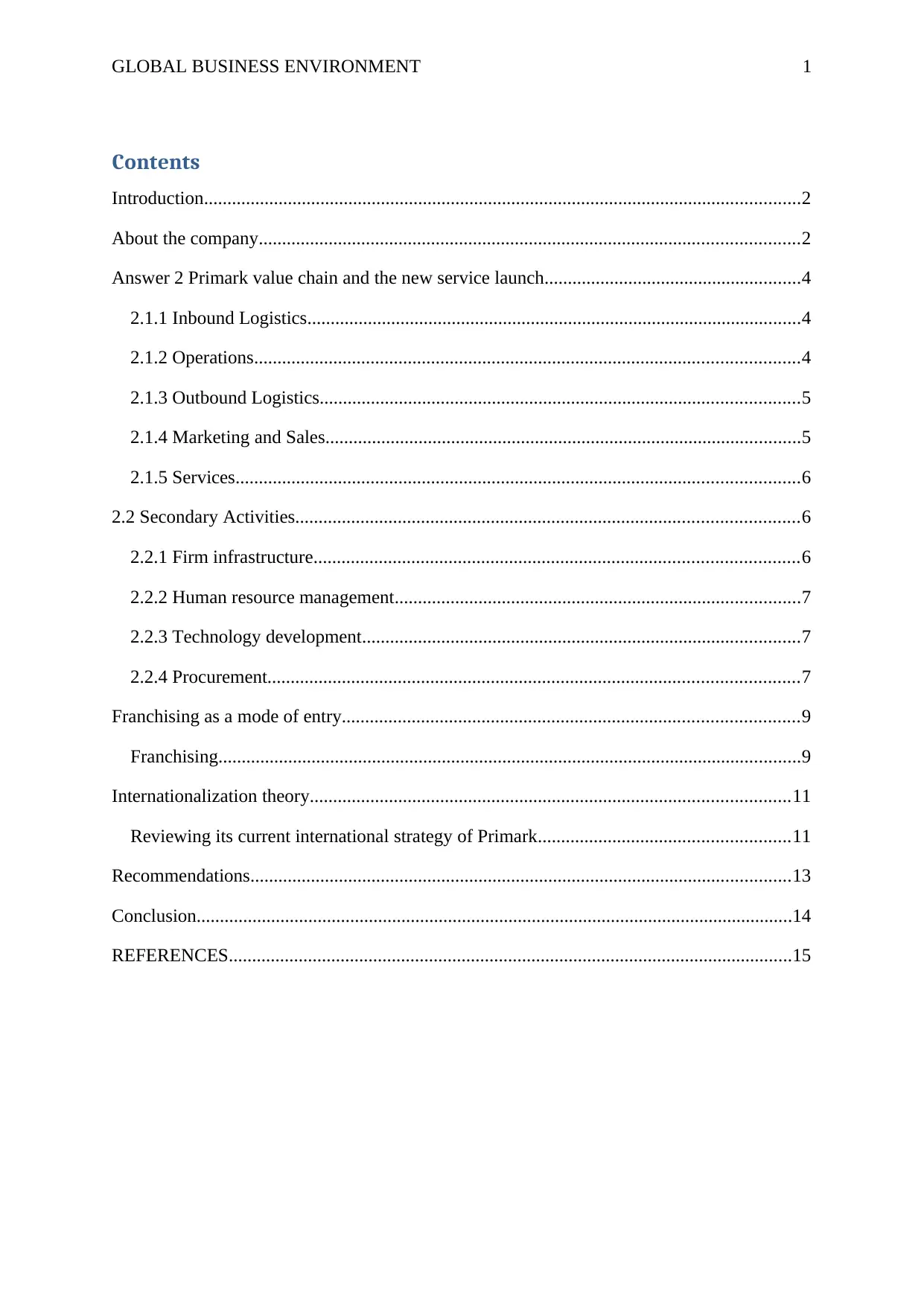
GLOBAL BUSINESS ENVIRONMENT 1
Contents
Introduction................................................................................................................................2
About the company....................................................................................................................2
Answer 2 Primark value chain and the new service launch.......................................................4
2.1.1 Inbound Logistics..........................................................................................................4
2.1.2 Operations.....................................................................................................................4
2.1.3 Outbound Logistics.......................................................................................................5
2.1.4 Marketing and Sales......................................................................................................5
2.1.5 Services.........................................................................................................................6
2.2 Secondary Activities............................................................................................................6
2.2.1 Firm infrastructure........................................................................................................6
2.2.2 Human resource management.......................................................................................7
2.2.3 Technology development..............................................................................................7
2.2.4 Procurement..................................................................................................................7
Franchising as a mode of entry..................................................................................................9
Franchising.............................................................................................................................9
Internationalization theory.......................................................................................................11
Reviewing its current international strategy of Primark......................................................11
Recommendations....................................................................................................................13
Conclusion................................................................................................................................14
REFERENCES.........................................................................................................................15
Contents
Introduction................................................................................................................................2
About the company....................................................................................................................2
Answer 2 Primark value chain and the new service launch.......................................................4
2.1.1 Inbound Logistics..........................................................................................................4
2.1.2 Operations.....................................................................................................................4
2.1.3 Outbound Logistics.......................................................................................................5
2.1.4 Marketing and Sales......................................................................................................5
2.1.5 Services.........................................................................................................................6
2.2 Secondary Activities............................................................................................................6
2.2.1 Firm infrastructure........................................................................................................6
2.2.2 Human resource management.......................................................................................7
2.2.3 Technology development..............................................................................................7
2.2.4 Procurement..................................................................................................................7
Franchising as a mode of entry..................................................................................................9
Franchising.............................................................................................................................9
Internationalization theory.......................................................................................................11
Reviewing its current international strategy of Primark......................................................11
Recommendations....................................................................................................................13
Conclusion................................................................................................................................14
REFERENCES.........................................................................................................................15
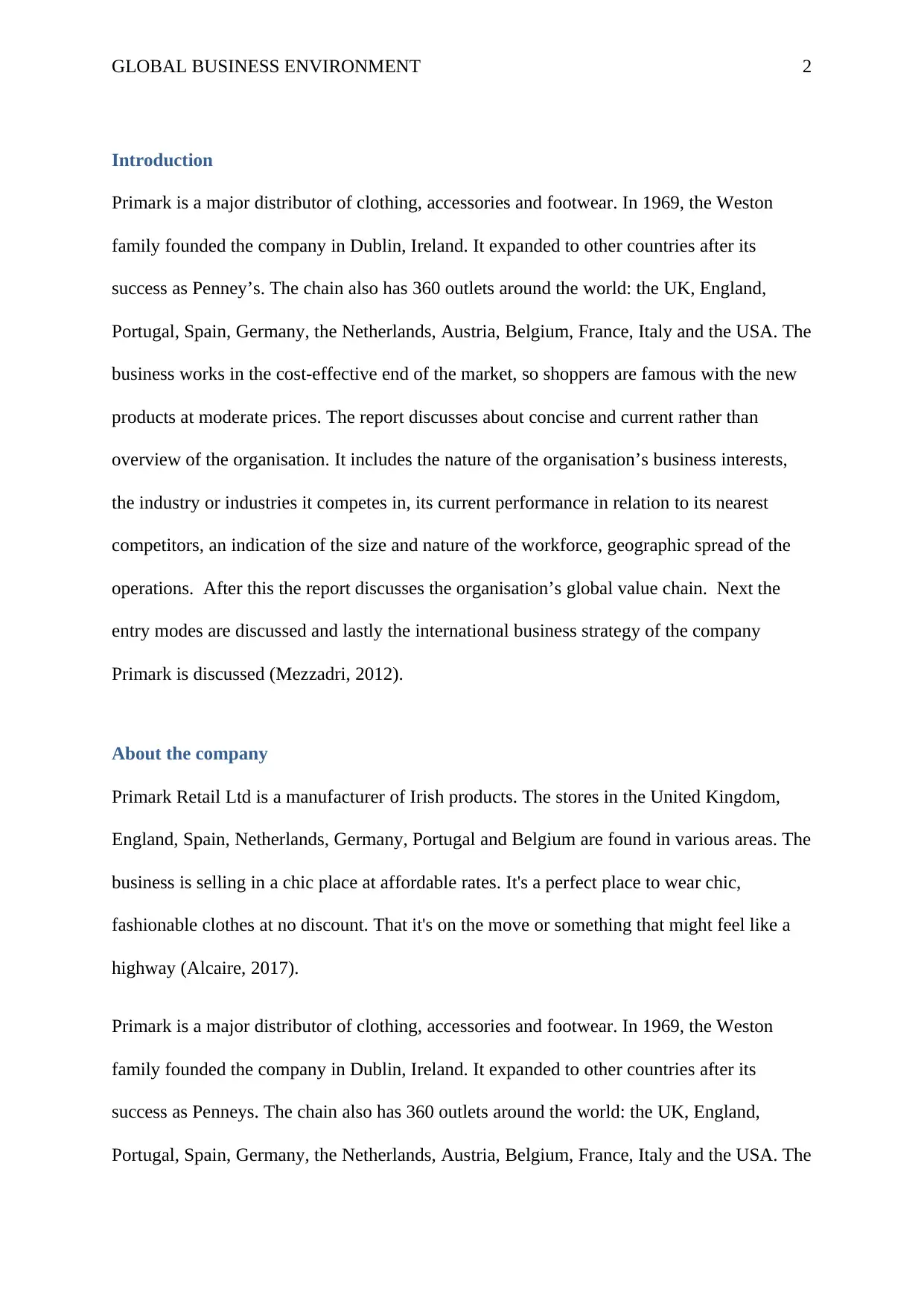
GLOBAL BUSINESS ENVIRONMENT 2
Introduction
Primark is a major distributor of clothing, accessories and footwear. In 1969, the Weston
family founded the company in Dublin, Ireland. It expanded to other countries after its
success as Penney’s. The chain also has 360 outlets around the world: the UK, England,
Portugal, Spain, Germany, the Netherlands, Austria, Belgium, France, Italy and the USA. The
business works in the cost-effective end of the market, so shoppers are famous with the new
products at moderate prices. The report discusses about concise and current rather than
overview of the organisation. It includes the nature of the organisation’s business interests,
the industry or industries it competes in, its current performance in relation to its nearest
competitors, an indication of the size and nature of the workforce, geographic spread of the
operations. After this the report discusses the organisation’s global value chain. Next the
entry modes are discussed and lastly the international business strategy of the company
Primark is discussed (Mezzadri, 2012).
About the company
Primark Retail Ltd is a manufacturer of Irish products. The stores in the United Kingdom,
England, Spain, Netherlands, Germany, Portugal and Belgium are found in various areas. The
business is selling in a chic place at affordable rates. It's a perfect place to wear chic,
fashionable clothes at no discount. That it's on the move or something that might feel like a
highway (Alcaire, 2017).
Primark is a major distributor of clothing, accessories and footwear. In 1969, the Weston
family founded the company in Dublin, Ireland. It expanded to other countries after its
success as Penneys. The chain also has 360 outlets around the world: the UK, England,
Portugal, Spain, Germany, the Netherlands, Austria, Belgium, France, Italy and the USA. The
Introduction
Primark is a major distributor of clothing, accessories and footwear. In 1969, the Weston
family founded the company in Dublin, Ireland. It expanded to other countries after its
success as Penney’s. The chain also has 360 outlets around the world: the UK, England,
Portugal, Spain, Germany, the Netherlands, Austria, Belgium, France, Italy and the USA. The
business works in the cost-effective end of the market, so shoppers are famous with the new
products at moderate prices. The report discusses about concise and current rather than
overview of the organisation. It includes the nature of the organisation’s business interests,
the industry or industries it competes in, its current performance in relation to its nearest
competitors, an indication of the size and nature of the workforce, geographic spread of the
operations. After this the report discusses the organisation’s global value chain. Next the
entry modes are discussed and lastly the international business strategy of the company
Primark is discussed (Mezzadri, 2012).
About the company
Primark Retail Ltd is a manufacturer of Irish products. The stores in the United Kingdom,
England, Spain, Netherlands, Germany, Portugal and Belgium are found in various areas. The
business is selling in a chic place at affordable rates. It's a perfect place to wear chic,
fashionable clothes at no discount. That it's on the move or something that might feel like a
highway (Alcaire, 2017).
Primark is a major distributor of clothing, accessories and footwear. In 1969, the Weston
family founded the company in Dublin, Ireland. It expanded to other countries after its
success as Penneys. The chain also has 360 outlets around the world: the UK, England,
Portugal, Spain, Germany, the Netherlands, Austria, Belgium, France, Italy and the USA. The
⊘ This is a preview!⊘
Do you want full access?
Subscribe today to unlock all pages.

Trusted by 1+ million students worldwide
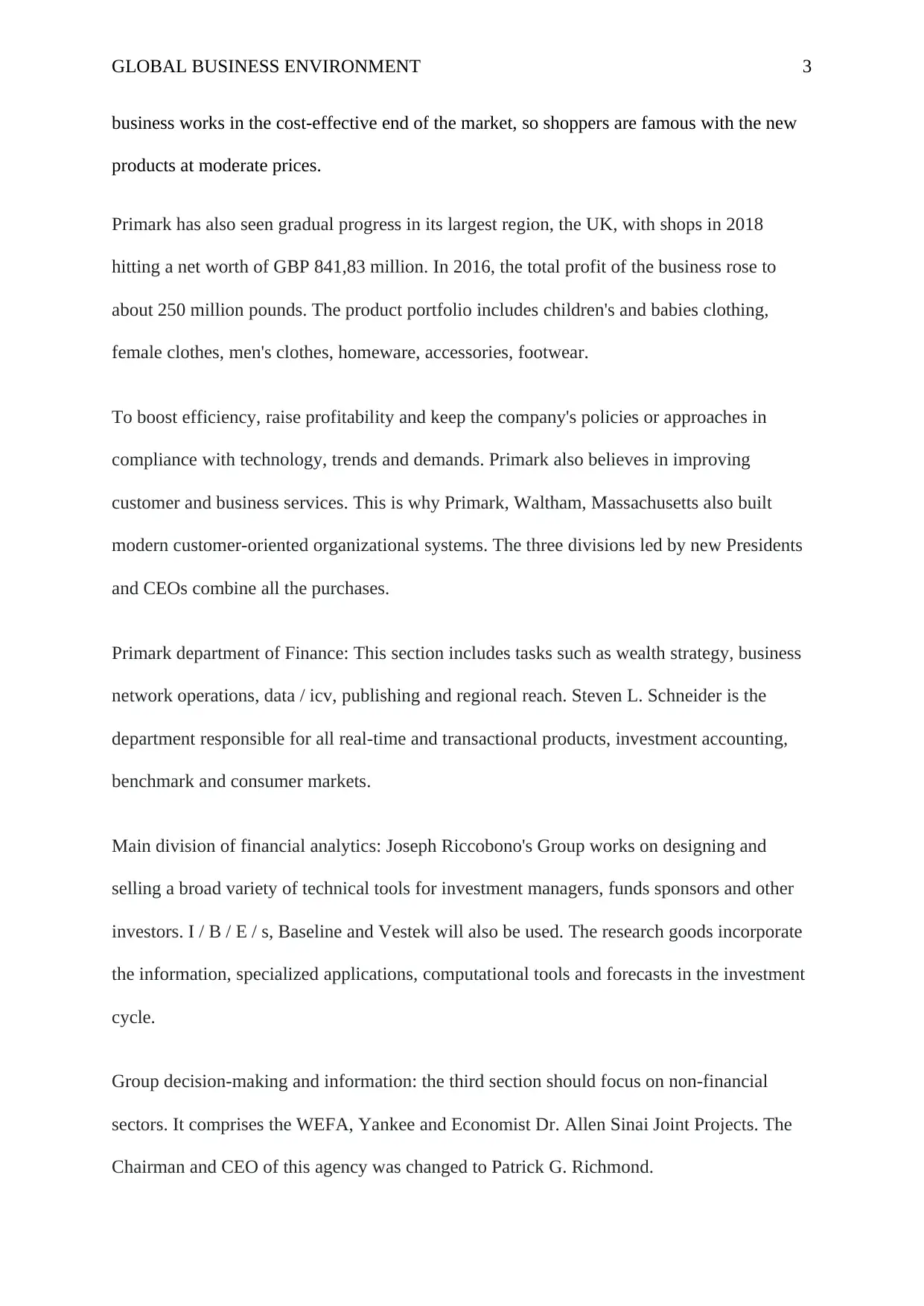
GLOBAL BUSINESS ENVIRONMENT 3
business works in the cost-effective end of the market, so shoppers are famous with the new
products at moderate prices.
Primark has also seen gradual progress in its largest region, the UK, with shops in 2018
hitting a net worth of GBP 841,83 million. In 2016, the total profit of the business rose to
about 250 million pounds. The product portfolio includes children's and babies clothing,
female clothes, men's clothes, homeware, accessories, footwear.
To boost efficiency, raise profitability and keep the company's policies or approaches in
compliance with technology, trends and demands. Primark also believes in improving
customer and business services. This is why Primark, Waltham, Massachusetts also built
modern customer-oriented organizational systems. The three divisions led by new Presidents
and CEOs combine all the purchases.
Primark department of Finance: This section includes tasks such as wealth strategy, business
network operations, data / icv, publishing and regional reach. Steven L. Schneider is the
department responsible for all real-time and transactional products, investment accounting,
benchmark and consumer markets.
Main division of financial analytics: Joseph Riccobono's Group works on designing and
selling a broad variety of technical tools for investment managers, funds sponsors and other
investors. I / B / E / s, Baseline and Vestek will also be used. The research goods incorporate
the information, specialized applications, computational tools and forecasts in the investment
cycle.
Group decision-making and information: the third section should focus on non-financial
sectors. It comprises the WEFA, Yankee and Economist Dr. Allen Sinai Joint Projects. The
Chairman and CEO of this agency was changed to Patrick G. Richmond.
business works in the cost-effective end of the market, so shoppers are famous with the new
products at moderate prices.
Primark has also seen gradual progress in its largest region, the UK, with shops in 2018
hitting a net worth of GBP 841,83 million. In 2016, the total profit of the business rose to
about 250 million pounds. The product portfolio includes children's and babies clothing,
female clothes, men's clothes, homeware, accessories, footwear.
To boost efficiency, raise profitability and keep the company's policies or approaches in
compliance with technology, trends and demands. Primark also believes in improving
customer and business services. This is why Primark, Waltham, Massachusetts also built
modern customer-oriented organizational systems. The three divisions led by new Presidents
and CEOs combine all the purchases.
Primark department of Finance: This section includes tasks such as wealth strategy, business
network operations, data / icv, publishing and regional reach. Steven L. Schneider is the
department responsible for all real-time and transactional products, investment accounting,
benchmark and consumer markets.
Main division of financial analytics: Joseph Riccobono's Group works on designing and
selling a broad variety of technical tools for investment managers, funds sponsors and other
investors. I / B / E / s, Baseline and Vestek will also be used. The research goods incorporate
the information, specialized applications, computational tools and forecasts in the investment
cycle.
Group decision-making and information: the third section should focus on non-financial
sectors. It comprises the WEFA, Yankee and Economist Dr. Allen Sinai Joint Projects. The
Chairman and CEO of this agency was changed to Patrick G. Richmond.
Paraphrase This Document
Need a fresh take? Get an instant paraphrase of this document with our AI Paraphraser
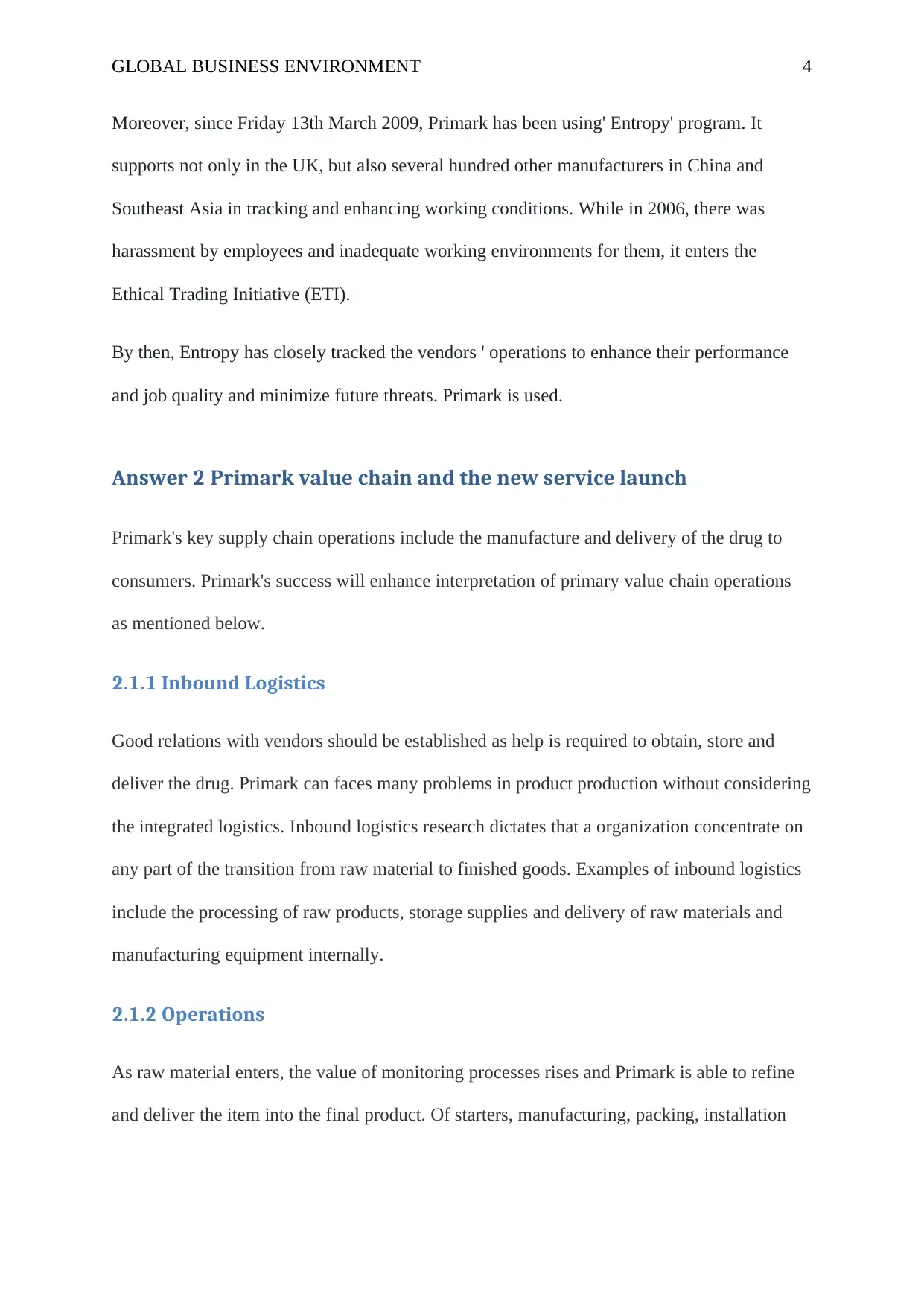
GLOBAL BUSINESS ENVIRONMENT 4
Moreover, since Friday 13th March 2009, Primark has been using' Entropy' program. It
supports not only in the UK, but also several hundred other manufacturers in China and
Southeast Asia in tracking and enhancing working conditions. While in 2006, there was
harassment by employees and inadequate working environments for them, it enters the
Ethical Trading Initiative (ETI).
By then, Entropy has closely tracked the vendors ' operations to enhance their performance
and job quality and minimize future threats. Primark is used.
Answer 2 Primark value chain and the new service launch
Primark's key supply chain operations include the manufacture and delivery of the drug to
consumers. Primark's success will enhance interpretation of primary value chain operations
as mentioned below.
2.1.1 Inbound Logistics
Good relations with vendors should be established as help is required to obtain, store and
deliver the drug. Primark can faces many problems in product production without considering
the integrated logistics. Inbound logistics research dictates that a organization concentrate on
any part of the transition from raw material to finished goods. Examples of inbound logistics
include the processing of raw products, storage supplies and delivery of raw materials and
manufacturing equipment internally.
2.1.2 Operations
As raw material enters, the value of monitoring processes rises and Primark is able to refine
and deliver the item into the final product. Of starters, manufacturing, packing, installation
Moreover, since Friday 13th March 2009, Primark has been using' Entropy' program. It
supports not only in the UK, but also several hundred other manufacturers in China and
Southeast Asia in tracking and enhancing working conditions. While in 2006, there was
harassment by employees and inadequate working environments for them, it enters the
Ethical Trading Initiative (ETI).
By then, Entropy has closely tracked the vendors ' operations to enhance their performance
and job quality and minimize future threats. Primark is used.
Answer 2 Primark value chain and the new service launch
Primark's key supply chain operations include the manufacture and delivery of the drug to
consumers. Primark's success will enhance interpretation of primary value chain operations
as mentioned below.
2.1.1 Inbound Logistics
Good relations with vendors should be established as help is required to obtain, store and
deliver the drug. Primark can faces many problems in product production without considering
the integrated logistics. Inbound logistics research dictates that a organization concentrate on
any part of the transition from raw material to finished goods. Examples of inbound logistics
include the processing of raw products, storage supplies and delivery of raw materials and
manufacturing equipment internally.
2.1.2 Operations
As raw material enters, the value of monitoring processes rises and Primark is able to refine
and deliver the item into the final product. Of starters, manufacturing, packing, installation

GLOBAL BUSINESS ENVIRONMENT 5
and testing are organizational tasks. Repair and repair of facilities is also protected under this
definition.
This encompasses production as well as business activities. For increasing profitability,
optimizing performance and ensuring Primark's competitive competitiveness, it is necessary
to evaluate operational activities. The increased productivity will lead to the positive
production, competitiveness and competitive advantage of Primark.
2.1.3 Outbound Logistics
Exit logistic operations involve practices, where the commodity is shipped to the consumer
through different intermediaries. Several operations in the field of outgoing logistics include
inventory management, packaging, preparation, order processing, transport and distribution.
In order to exploit competitively desirable opportunities and meet their market development
goals, Primark will evaluate and maximize production logistics.
While the timely control of outgoing operations with optimum costs and the delivery of
goods has negligible detrimental effect on efficiency, it maximizes consumer satisfaction and
enhances business' growth potential. Because the sold goods are perishable and need quick
distribution to end consumers, Primark will add particular attention to its outbound supply
chains.
2.1.4 Marketing and Sales
Primark would at this time demonstrate the features and reference points of the goods sold
and reassure the consumers that its offerings are superior than rivals. It is only when Primark
engages in promotion and selling efforts that high-quality merchandise is manufactured at an
reasonable cost and with distinctive characteristics. There is an significant function here for
the selling managers and marketers.
and testing are organizational tasks. Repair and repair of facilities is also protected under this
definition.
This encompasses production as well as business activities. For increasing profitability,
optimizing performance and ensuring Primark's competitive competitiveness, it is necessary
to evaluate operational activities. The increased productivity will lead to the positive
production, competitiveness and competitive advantage of Primark.
2.1.3 Outbound Logistics
Exit logistic operations involve practices, where the commodity is shipped to the consumer
through different intermediaries. Several operations in the field of outgoing logistics include
inventory management, packaging, preparation, order processing, transport and distribution.
In order to exploit competitively desirable opportunities and meet their market development
goals, Primark will evaluate and maximize production logistics.
While the timely control of outgoing operations with optimum costs and the delivery of
goods has negligible detrimental effect on efficiency, it maximizes consumer satisfaction and
enhances business' growth potential. Because the sold goods are perishable and need quick
distribution to end consumers, Primark will add particular attention to its outbound supply
chains.
2.1.4 Marketing and Sales
Primark would at this time demonstrate the features and reference points of the goods sold
and reassure the consumers that its offerings are superior than rivals. It is only when Primark
engages in promotion and selling efforts that high-quality merchandise is manufactured at an
reasonable cost and with distinctive characteristics. There is an significant function here for
the selling managers and marketers.
⊘ This is a preview!⊘
Do you want full access?
Subscribe today to unlock all pages.

Trusted by 1+ million students worldwide
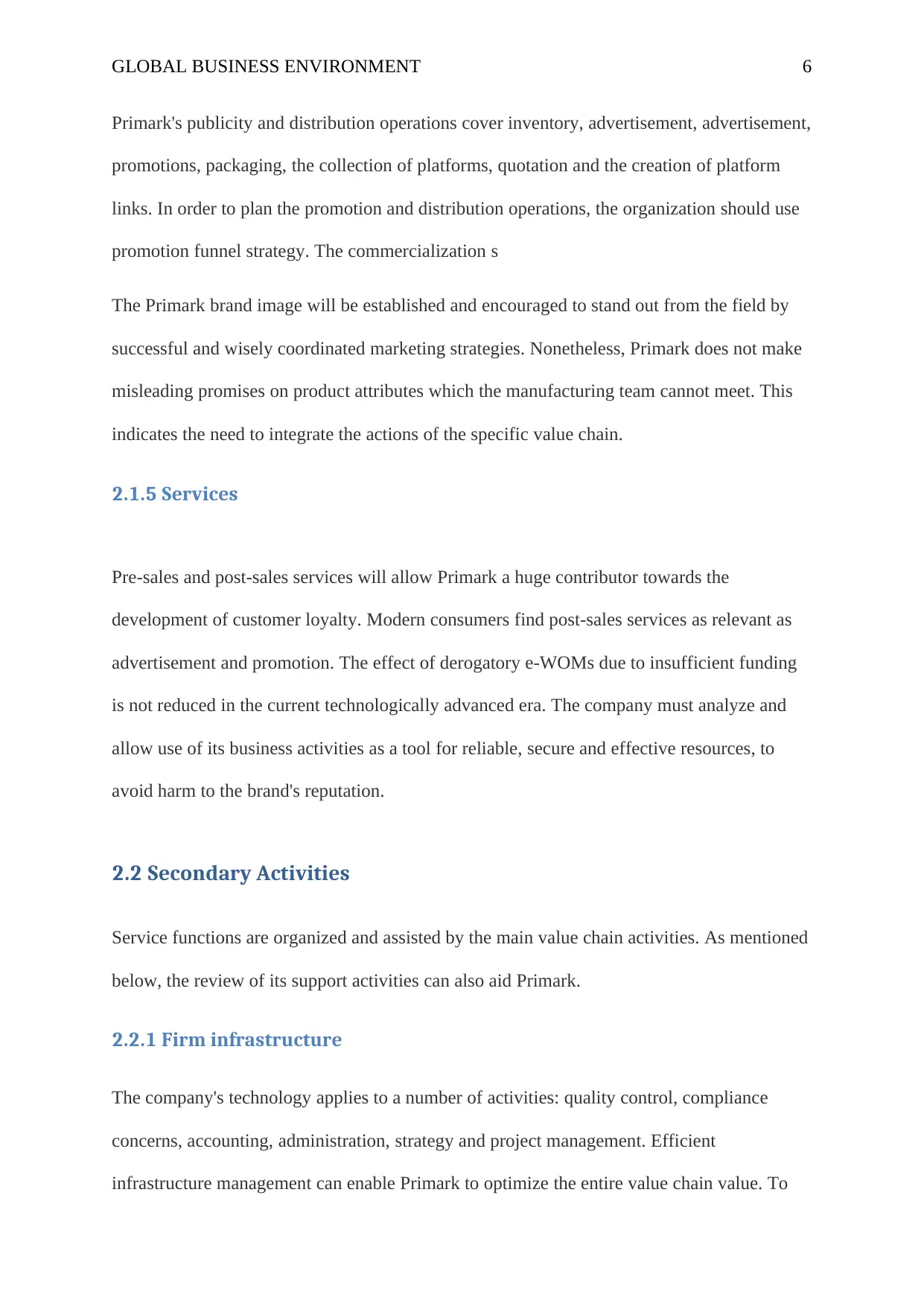
GLOBAL BUSINESS ENVIRONMENT 6
Primark's publicity and distribution operations cover inventory, advertisement, advertisement,
promotions, packaging, the collection of platforms, quotation and the creation of platform
links. In order to plan the promotion and distribution operations, the organization should use
promotion funnel strategy. The commercialization s
The Primark brand image will be established and encouraged to stand out from the field by
successful and wisely coordinated marketing strategies. Nonetheless, Primark does not make
misleading promises on product attributes which the manufacturing team cannot meet. This
indicates the need to integrate the actions of the specific value chain.
2.1.5 Services
Pre-sales and post-sales services will allow Primark a huge contributor towards the
development of customer loyalty. Modern consumers find post-sales services as relevant as
advertisement and promotion. The effect of derogatory e-WOMs due to insufficient funding
is not reduced in the current technologically advanced era. The company must analyze and
allow use of its business activities as a tool for reliable, secure and effective resources, to
avoid harm to the brand's reputation.
2.2 Secondary Activities
Service functions are organized and assisted by the main value chain activities. As mentioned
below, the review of its support activities can also aid Primark.
2.2.1 Firm infrastructure
The company's technology applies to a number of activities: quality control, compliance
concerns, accounting, administration, strategy and project management. Efficient
infrastructure management can enable Primark to optimize the entire value chain value. To
Primark's publicity and distribution operations cover inventory, advertisement, advertisement,
promotions, packaging, the collection of platforms, quotation and the creation of platform
links. In order to plan the promotion and distribution operations, the organization should use
promotion funnel strategy. The commercialization s
The Primark brand image will be established and encouraged to stand out from the field by
successful and wisely coordinated marketing strategies. Nonetheless, Primark does not make
misleading promises on product attributes which the manufacturing team cannot meet. This
indicates the need to integrate the actions of the specific value chain.
2.1.5 Services
Pre-sales and post-sales services will allow Primark a huge contributor towards the
development of customer loyalty. Modern consumers find post-sales services as relevant as
advertisement and promotion. The effect of derogatory e-WOMs due to insufficient funding
is not reduced in the current technologically advanced era. The company must analyze and
allow use of its business activities as a tool for reliable, secure and effective resources, to
avoid harm to the brand's reputation.
2.2 Secondary Activities
Service functions are organized and assisted by the main value chain activities. As mentioned
below, the review of its support activities can also aid Primark.
2.2.1 Firm infrastructure
The company's technology applies to a number of activities: quality control, compliance
concerns, accounting, administration, strategy and project management. Efficient
infrastructure management can enable Primark to optimize the entire value chain value. To
Paraphrase This Document
Need a fresh take? Get an instant paraphrase of this document with our AI Paraphraser
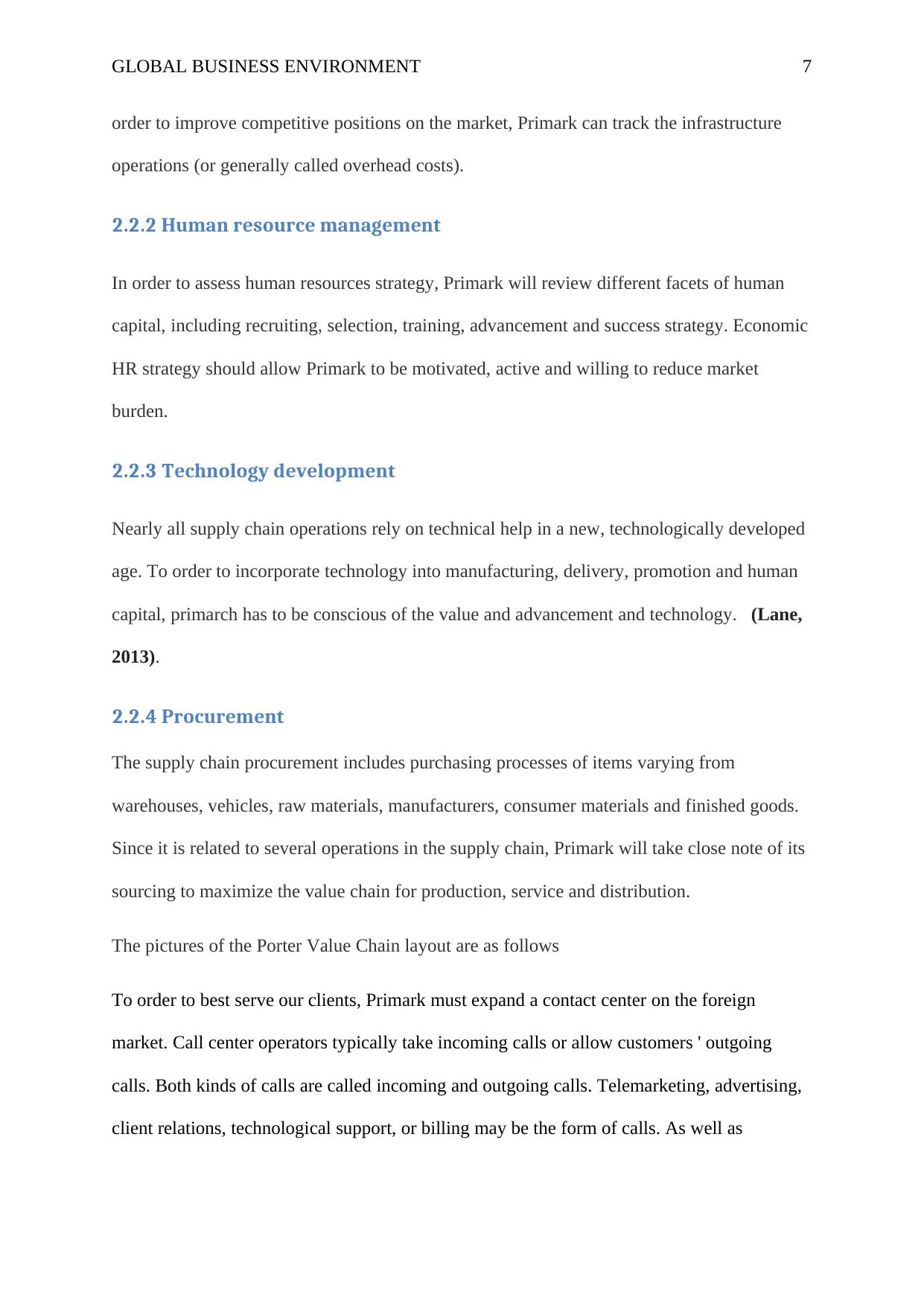
GLOBAL BUSINESS ENVIRONMENT 7
order to improve competitive positions on the market, Primark can track the infrastructure
operations (or generally called overhead costs).
2.2.2 Human resource management
In order to assess human resources strategy, Primark will review different facets of human
capital, including recruiting, selection, training, advancement and success strategy. Economic
HR strategy should allow Primark to be motivated, active and willing to reduce market
burden.
2.2.3 Technology development
Nearly all supply chain operations rely on technical help in a new, technologically developed
age. To order to incorporate technology into manufacturing, delivery, promotion and human
capital, primarch has to be conscious of the value and advancement and technology. (Lane,
2013).
2.2.4 Procurement
The supply chain procurement includes purchasing processes of items varying from
warehouses, vehicles, raw materials, manufacturers, consumer materials and finished goods.
Since it is related to several operations in the supply chain, Primark will take close note of its
sourcing to maximize the value chain for production, service and distribution.
The pictures of the Porter Value Chain layout are as follows
To order to best serve our clients, Primark must expand a contact center on the foreign
market. Call center operators typically take incoming calls or allow customers ' outgoing
calls. Both kinds of calls are called incoming and outgoing calls. Telemarketing, advertising,
client relations, technological support, or billing may be the form of calls. As well as
order to improve competitive positions on the market, Primark can track the infrastructure
operations (or generally called overhead costs).
2.2.2 Human resource management
In order to assess human resources strategy, Primark will review different facets of human
capital, including recruiting, selection, training, advancement and success strategy. Economic
HR strategy should allow Primark to be motivated, active and willing to reduce market
burden.
2.2.3 Technology development
Nearly all supply chain operations rely on technical help in a new, technologically developed
age. To order to incorporate technology into manufacturing, delivery, promotion and human
capital, primarch has to be conscious of the value and advancement and technology. (Lane,
2013).
2.2.4 Procurement
The supply chain procurement includes purchasing processes of items varying from
warehouses, vehicles, raw materials, manufacturers, consumer materials and finished goods.
Since it is related to several operations in the supply chain, Primark will take close note of its
sourcing to maximize the value chain for production, service and distribution.
The pictures of the Porter Value Chain layout are as follows
To order to best serve our clients, Primark must expand a contact center on the foreign
market. Call center operators typically take incoming calls or allow customers ' outgoing
calls. Both kinds of calls are called incoming and outgoing calls. Telemarketing, advertising,
client relations, technological support, or billing may be the form of calls. As well as
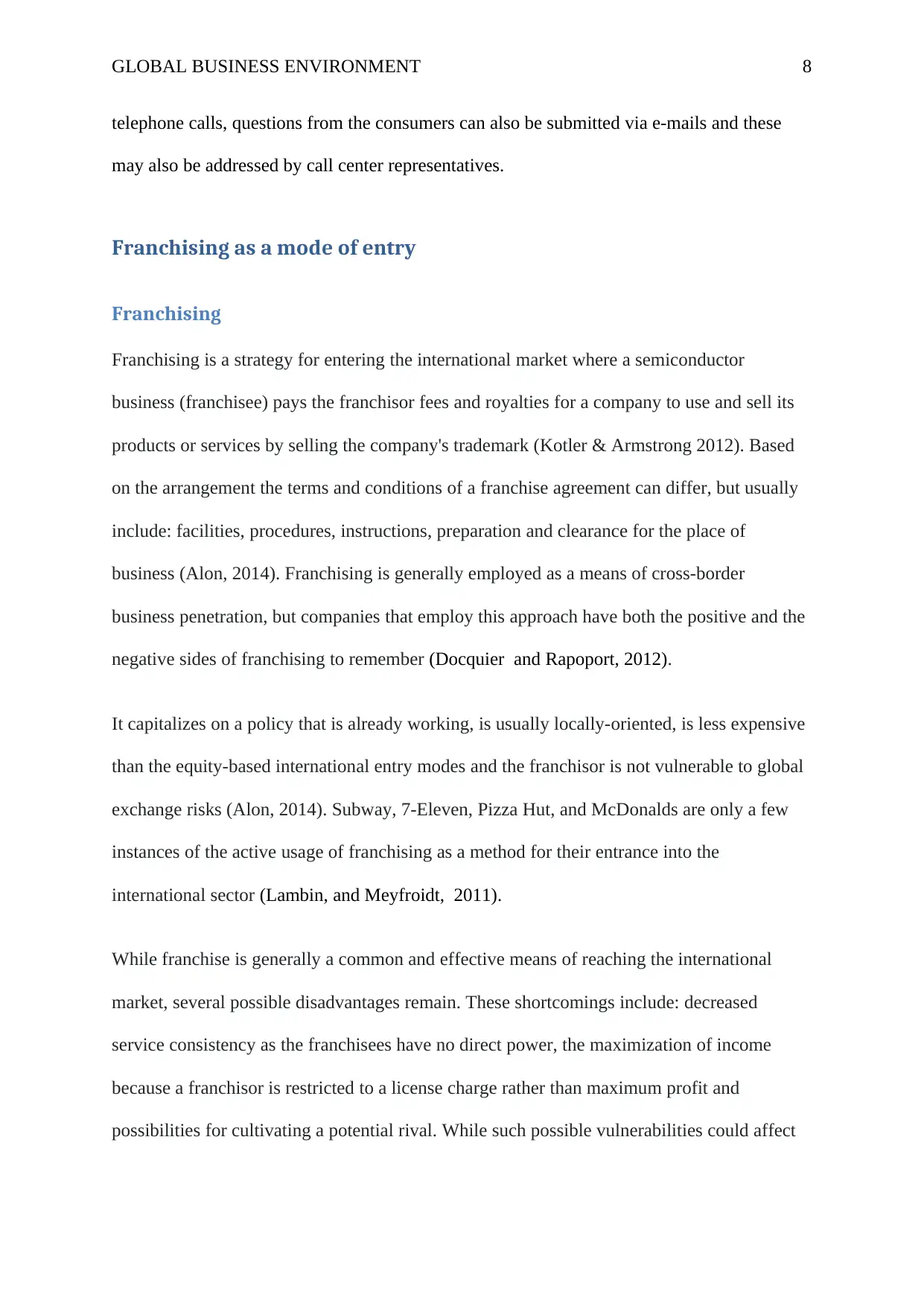
GLOBAL BUSINESS ENVIRONMENT 8
telephone calls, questions from the consumers can also be submitted via e-mails and these
may also be addressed by call center representatives.
Franchising as a mode of entry
Franchising
Franchising is a strategy for entering the international market where a semiconductor
business (franchisee) pays the franchisor fees and royalties for a company to use and sell its
products or services by selling the company's trademark (Kotler & Armstrong 2012). Based
on the arrangement the terms and conditions of a franchise agreement can differ, but usually
include: facilities, procedures, instructions, preparation and clearance for the place of
business (Alon, 2014). Franchising is generally employed as a means of cross-border
business penetration, but companies that employ this approach have both the positive and the
negative sides of franchising to remember (Docquier and Rapoport, 2012).
It capitalizes on a policy that is already working, is usually locally-oriented, is less expensive
than the equity-based international entry modes and the franchisor is not vulnerable to global
exchange risks (Alon, 2014). Subway, 7-Eleven, Pizza Hut, and McDonalds are only a few
instances of the active usage of franchising as a method for their entrance into the
international sector (Lambin, and Meyfroidt, 2011).
While franchise is generally a common and effective means of reaching the international
market, several possible disadvantages remain. These shortcomings include: decreased
service consistency as the franchisees have no direct power, the maximization of income
because a franchisor is restricted to a license charge rather than maximum profit and
possibilities for cultivating a potential rival. While such possible vulnerabilities could affect
telephone calls, questions from the consumers can also be submitted via e-mails and these
may also be addressed by call center representatives.
Franchising as a mode of entry
Franchising
Franchising is a strategy for entering the international market where a semiconductor
business (franchisee) pays the franchisor fees and royalties for a company to use and sell its
products or services by selling the company's trademark (Kotler & Armstrong 2012). Based
on the arrangement the terms and conditions of a franchise agreement can differ, but usually
include: facilities, procedures, instructions, preparation and clearance for the place of
business (Alon, 2014). Franchising is generally employed as a means of cross-border
business penetration, but companies that employ this approach have both the positive and the
negative sides of franchising to remember (Docquier and Rapoport, 2012).
It capitalizes on a policy that is already working, is usually locally-oriented, is less expensive
than the equity-based international entry modes and the franchisor is not vulnerable to global
exchange risks (Alon, 2014). Subway, 7-Eleven, Pizza Hut, and McDonalds are only a few
instances of the active usage of franchising as a method for their entrance into the
international sector (Lambin, and Meyfroidt, 2011).
While franchise is generally a common and effective means of reaching the international
market, several possible disadvantages remain. These shortcomings include: decreased
service consistency as the franchisees have no direct power, the maximization of income
because a franchisor is restricted to a license charge rather than maximum profit and
possibilities for cultivating a potential rival. While such possible vulnerabilities could affect
⊘ This is a preview!⊘
Do you want full access?
Subscribe today to unlock all pages.

Trusted by 1+ million students worldwide
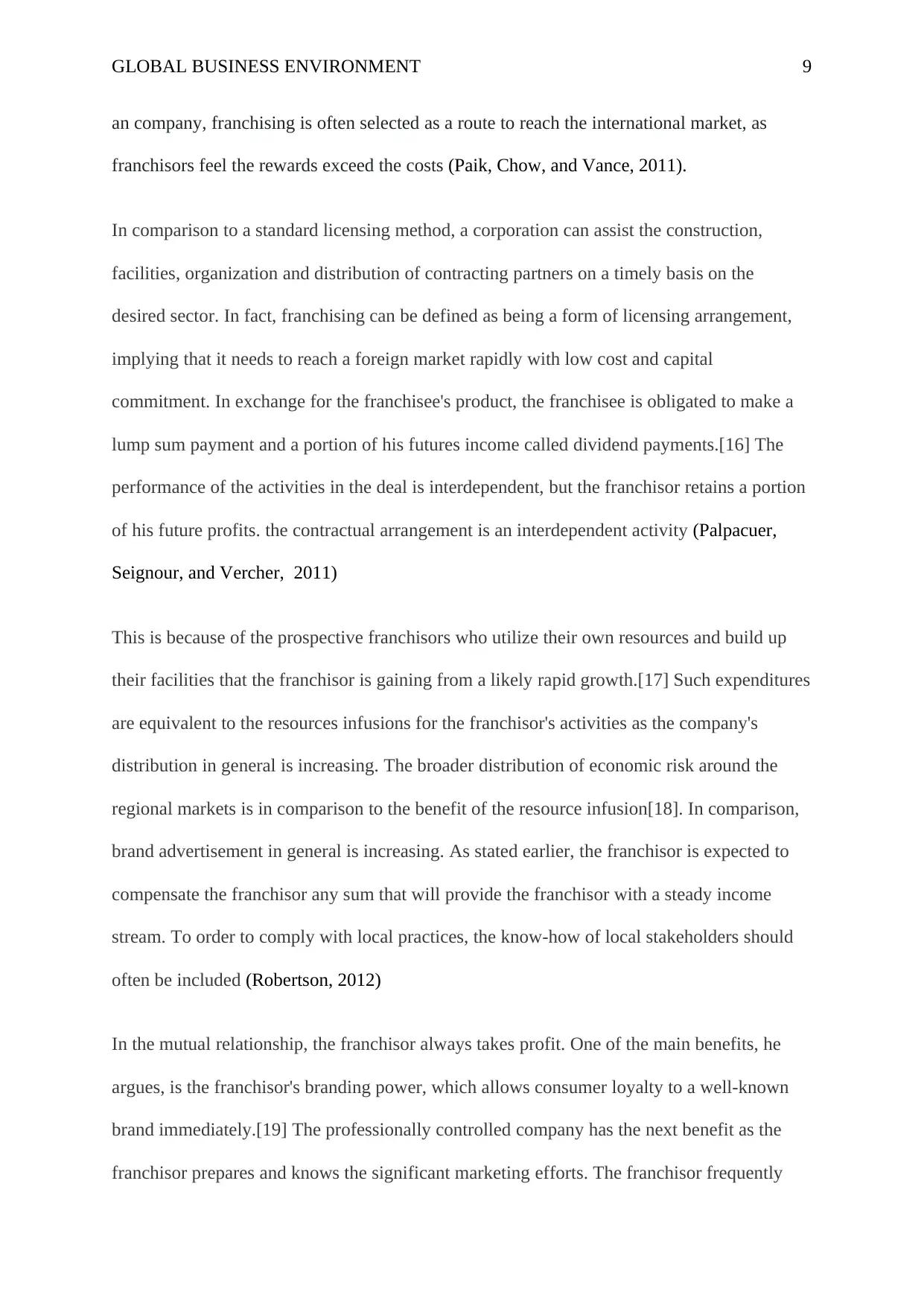
GLOBAL BUSINESS ENVIRONMENT 9
an company, franchising is often selected as a route to reach the international market, as
franchisors feel the rewards exceed the costs (Paik, Chow, and Vance, 2011).
In comparison to a standard licensing method, a corporation can assist the construction,
facilities, organization and distribution of contracting partners on a timely basis on the
desired sector. In fact, franchising can be defined as being a form of licensing arrangement,
implying that it needs to reach a foreign market rapidly with low cost and capital
commitment. In exchange for the franchisee's product, the franchisee is obligated to make a
lump sum payment and a portion of his futures income called dividend payments.[16] The
performance of the activities in the deal is interdependent, but the franchisor retains a portion
of his future profits. the contractual arrangement is an interdependent activity (Palpacuer,
Seignour, and Vercher, 2011)
This is because of the prospective franchisors who utilize their own resources and build up
their facilities that the franchisor is gaining from a likely rapid growth.[17] Such expenditures
are equivalent to the resources infusions for the franchisor's activities as the company's
distribution in general is increasing. The broader distribution of economic risk around the
regional markets is in comparison to the benefit of the resource infusion[18]. In comparison,
brand advertisement in general is increasing. As stated earlier, the franchisor is expected to
compensate the franchisor any sum that will provide the franchisor with a steady income
stream. To order to comply with local practices, the know-how of local stakeholders should
often be included (Robertson, 2012)
In the mutual relationship, the franchisor always takes profit. One of the main benefits, he
argues, is the franchisor's branding power, which allows consumer loyalty to a well-known
brand immediately.[19] The professionally controlled company has the next benefit as the
franchisor prepares and knows the significant marketing efforts. The franchisor frequently
an company, franchising is often selected as a route to reach the international market, as
franchisors feel the rewards exceed the costs (Paik, Chow, and Vance, 2011).
In comparison to a standard licensing method, a corporation can assist the construction,
facilities, organization and distribution of contracting partners on a timely basis on the
desired sector. In fact, franchising can be defined as being a form of licensing arrangement,
implying that it needs to reach a foreign market rapidly with low cost and capital
commitment. In exchange for the franchisee's product, the franchisee is obligated to make a
lump sum payment and a portion of his futures income called dividend payments.[16] The
performance of the activities in the deal is interdependent, but the franchisor retains a portion
of his future profits. the contractual arrangement is an interdependent activity (Palpacuer,
Seignour, and Vercher, 2011)
This is because of the prospective franchisors who utilize their own resources and build up
their facilities that the franchisor is gaining from a likely rapid growth.[17] Such expenditures
are equivalent to the resources infusions for the franchisor's activities as the company's
distribution in general is increasing. The broader distribution of economic risk around the
regional markets is in comparison to the benefit of the resource infusion[18]. In comparison,
brand advertisement in general is increasing. As stated earlier, the franchisor is expected to
compensate the franchisor any sum that will provide the franchisor with a steady income
stream. To order to comply with local practices, the know-how of local stakeholders should
often be included (Robertson, 2012)
In the mutual relationship, the franchisor always takes profit. One of the main benefits, he
argues, is the franchisor's branding power, which allows consumer loyalty to a well-known
brand immediately.[19] The professionally controlled company has the next benefit as the
franchisor prepares and knows the significant marketing efforts. The franchisor frequently
Paraphrase This Document
Need a fresh take? Get an instant paraphrase of this document with our AI Paraphraser
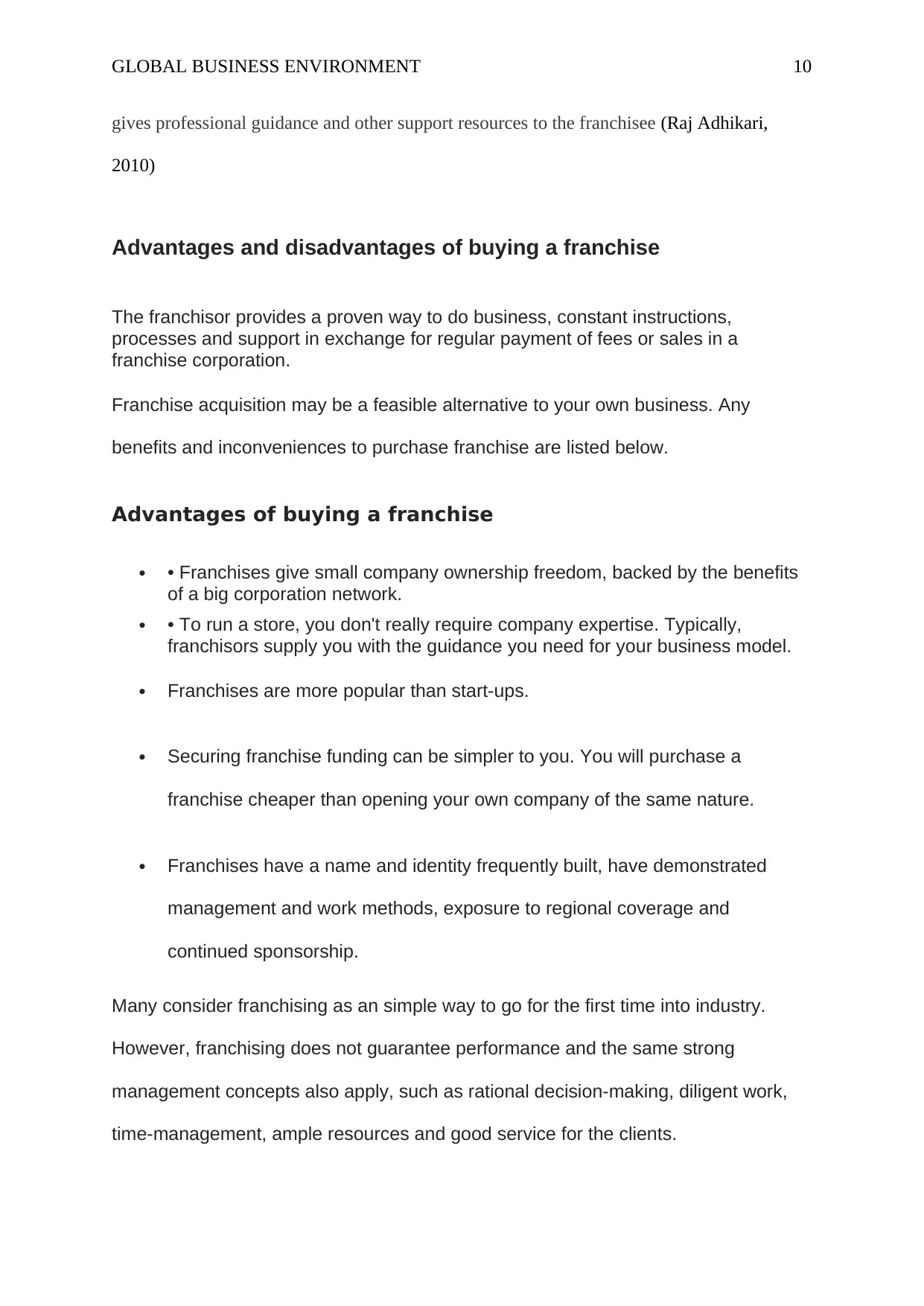
GLOBAL BUSINESS ENVIRONMENT 10
gives professional guidance and other support resources to the franchisee (Raj Adhikari,
2010)
Advantages and disadvantages of buying a franchise
The franchisor provides a proven way to do business, constant instructions,
processes and support in exchange for regular payment of fees or sales in a
franchise corporation.
Franchise acquisition may be a feasible alternative to your own business. Any
benefits and inconveniences to purchase franchise are listed below.
Advantages of buying a franchise
• Franchises give small company ownership freedom, backed by the benefits
of a big corporation network.
• To run a store, you don't really require company expertise. Typically,
franchisors supply you with the guidance you need for your business model.
Franchises are more popular than start-ups.
Securing franchise funding can be simpler to you. You will purchase a
franchise cheaper than opening your own company of the same nature.
Franchises have a name and identity frequently built, have demonstrated
management and work methods, exposure to regional coverage and
continued sponsorship.
Many consider franchising as an simple way to go for the first time into industry.
However, franchising does not guarantee performance and the same strong
management concepts also apply, such as rational decision-making, diligent work,
time-management, ample resources and good service for the clients.
gives professional guidance and other support resources to the franchisee (Raj Adhikari,
2010)
Advantages and disadvantages of buying a franchise
The franchisor provides a proven way to do business, constant instructions,
processes and support in exchange for regular payment of fees or sales in a
franchise corporation.
Franchise acquisition may be a feasible alternative to your own business. Any
benefits and inconveniences to purchase franchise are listed below.
Advantages of buying a franchise
• Franchises give small company ownership freedom, backed by the benefits
of a big corporation network.
• To run a store, you don't really require company expertise. Typically,
franchisors supply you with the guidance you need for your business model.
Franchises are more popular than start-ups.
Securing franchise funding can be simpler to you. You will purchase a
franchise cheaper than opening your own company of the same nature.
Franchises have a name and identity frequently built, have demonstrated
management and work methods, exposure to regional coverage and
continued sponsorship.
Many consider franchising as an simple way to go for the first time into industry.
However, franchising does not guarantee performance and the same strong
management concepts also apply, such as rational decision-making, diligent work,
time-management, ample resources and good service for the clients.
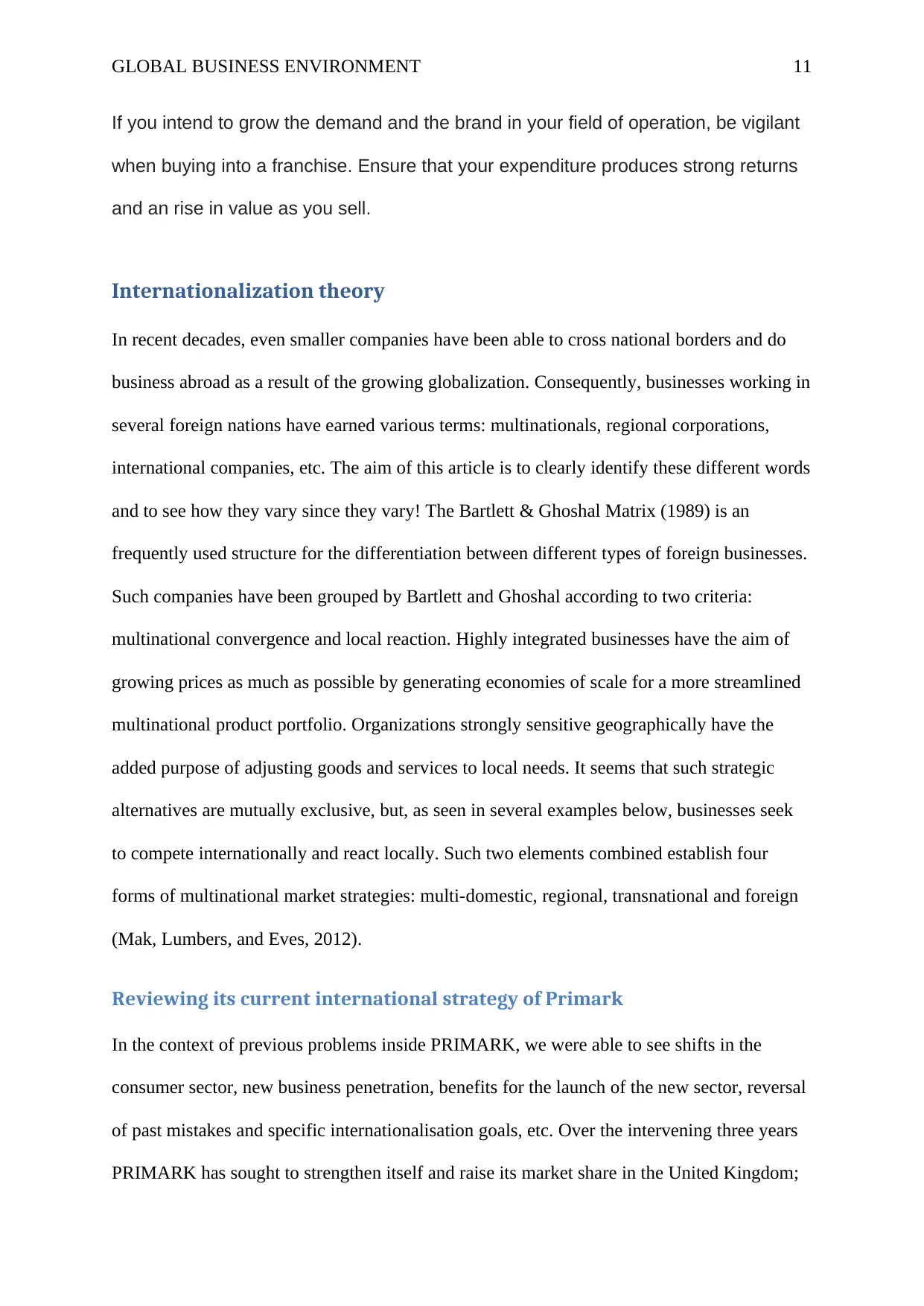
GLOBAL BUSINESS ENVIRONMENT 11
If you intend to grow the demand and the brand in your field of operation, be vigilant
when buying into a franchise. Ensure that your expenditure produces strong returns
and an rise in value as you sell.
Internationalization theory
In recent decades, even smaller companies have been able to cross national borders and do
business abroad as a result of the growing globalization. Consequently, businesses working in
several foreign nations have earned various terms: multinationals, regional corporations,
international companies, etc. The aim of this article is to clearly identify these different words
and to see how they vary since they vary! The Bartlett & Ghoshal Matrix (1989) is an
frequently used structure for the differentiation between different types of foreign businesses.
Such companies have been grouped by Bartlett and Ghoshal according to two criteria:
multinational convergence and local reaction. Highly integrated businesses have the aim of
growing prices as much as possible by generating economies of scale for a more streamlined
multinational product portfolio. Organizations strongly sensitive geographically have the
added purpose of adjusting goods and services to local needs. It seems that such strategic
alternatives are mutually exclusive, but, as seen in several examples below, businesses seek
to compete internationally and react locally. Such two elements combined establish four
forms of multinational market strategies: multi-domestic, regional, transnational and foreign
(Mak, Lumbers, and Eves, 2012).
Reviewing its current international strategy of Primark
In the context of previous problems inside PRIMARK, we were able to see shifts in the
consumer sector, new business penetration, benefits for the launch of the new sector, reversal
of past mistakes and specific internationalisation goals, etc. Over the intervening three years
PRIMARK has sought to strengthen itself and raise its market share in the United Kingdom;
If you intend to grow the demand and the brand in your field of operation, be vigilant
when buying into a franchise. Ensure that your expenditure produces strong returns
and an rise in value as you sell.
Internationalization theory
In recent decades, even smaller companies have been able to cross national borders and do
business abroad as a result of the growing globalization. Consequently, businesses working in
several foreign nations have earned various terms: multinationals, regional corporations,
international companies, etc. The aim of this article is to clearly identify these different words
and to see how they vary since they vary! The Bartlett & Ghoshal Matrix (1989) is an
frequently used structure for the differentiation between different types of foreign businesses.
Such companies have been grouped by Bartlett and Ghoshal according to two criteria:
multinational convergence and local reaction. Highly integrated businesses have the aim of
growing prices as much as possible by generating economies of scale for a more streamlined
multinational product portfolio. Organizations strongly sensitive geographically have the
added purpose of adjusting goods and services to local needs. It seems that such strategic
alternatives are mutually exclusive, but, as seen in several examples below, businesses seek
to compete internationally and react locally. Such two elements combined establish four
forms of multinational market strategies: multi-domestic, regional, transnational and foreign
(Mak, Lumbers, and Eves, 2012).
Reviewing its current international strategy of Primark
In the context of previous problems inside PRIMARK, we were able to see shifts in the
consumer sector, new business penetration, benefits for the launch of the new sector, reversal
of past mistakes and specific internationalisation goals, etc. Over the intervening three years
PRIMARK has sought to strengthen itself and raise its market share in the United Kingdom;
⊘ This is a preview!⊘
Do you want full access?
Subscribe today to unlock all pages.

Trusted by 1+ million students worldwide
1 out of 19
Related Documents
Your All-in-One AI-Powered Toolkit for Academic Success.
+13062052269
info@desklib.com
Available 24*7 on WhatsApp / Email
![[object Object]](/_next/static/media/star-bottom.7253800d.svg)
Unlock your academic potential
Copyright © 2020–2025 A2Z Services. All Rights Reserved. Developed and managed by ZUCOL.





